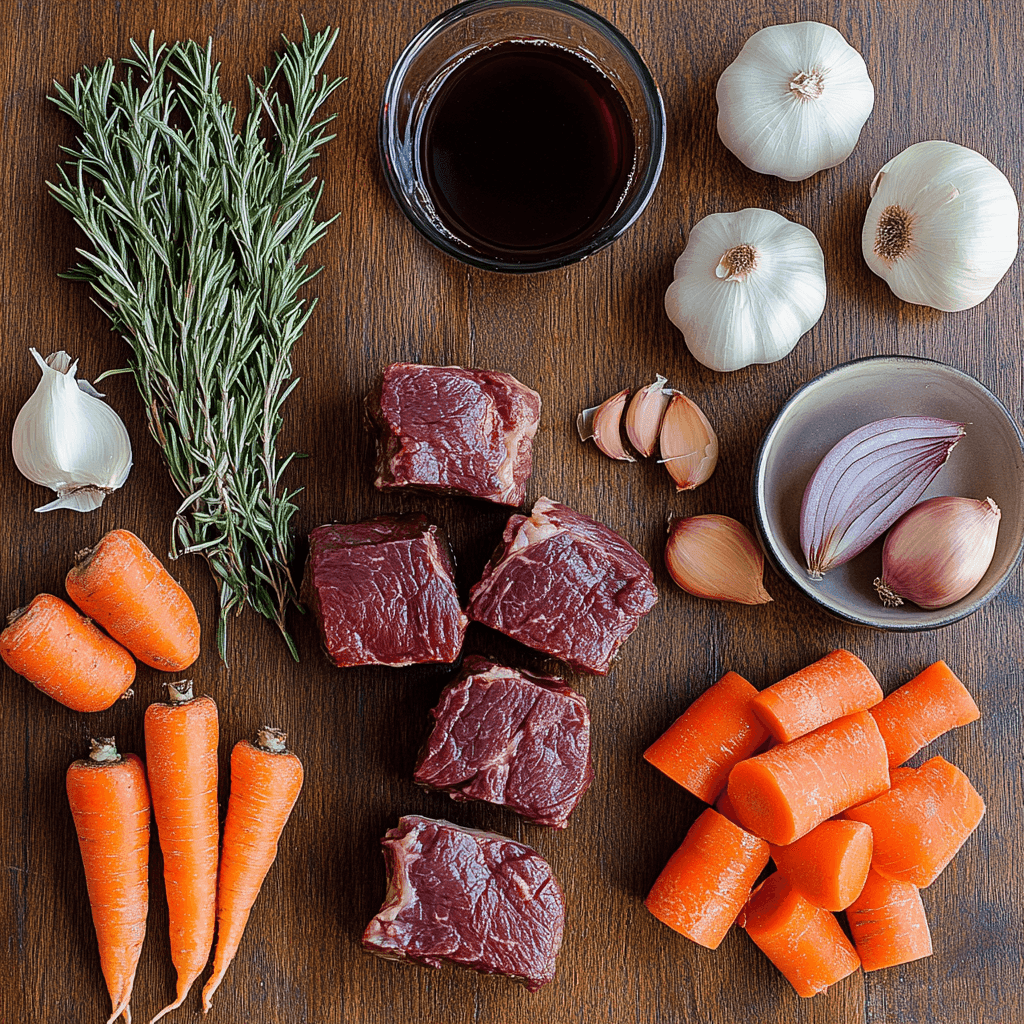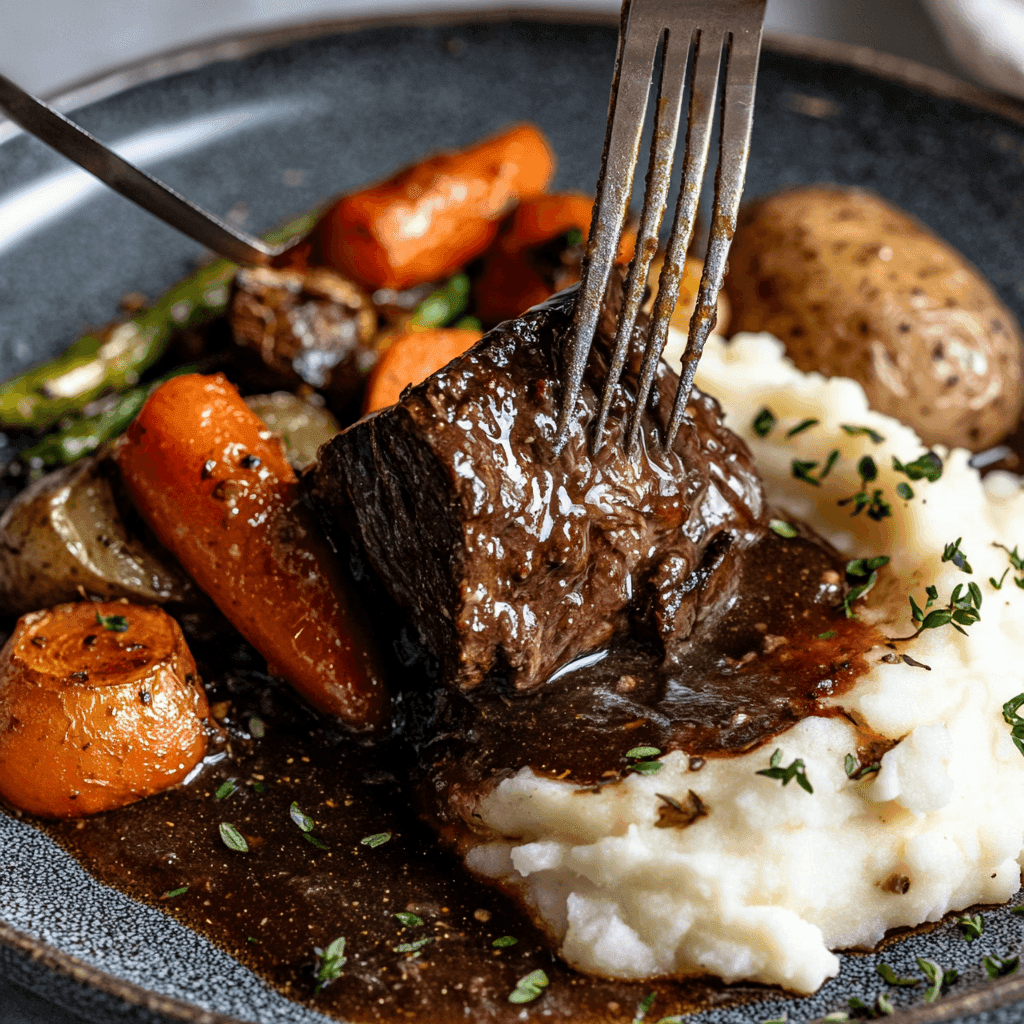Cooking slow-cooked beef can be tough, but with the right steps, you can get amazing results. Perfectly Tender Beef Cheeks are a treat that comes from slow cooking. This method turns tough meat into a soft, rich dish. To make perfectly tender beef cheeks, you need to know the basics of cooking them.
Cooking beef cheeks needs patience and careful attention. But the result is worth it. With the right methods and ingredients, you can make tasty beef dishes that impress everyone. Slow-cooked beef is perfect for a hearty stew or a tender roast.
Table of contents
- Key Takeaways
- Understanding Beef Cheeks: What Makes Them Special
- Essential Equipment for Cooking Beef Cheeks
- Selecting the Best Beef Cheeks at Your Butcher
- Preparing Your Perfectly Tender Beef Cheeks
- The Art of Seasoning and Marinating
- Step-by-Step Cooking Method
- Wine and Stock Pairing for Braising
- Troubleshooting Common Issues
- Serving Suggestions and Accompaniments
- Storage and Reheating Guidelines
- Conclusion: Mastering the Art of Beef Cheek Preparation
- FAQ
- What makes beef cheeks special and perfect for slow cooking?
- What type of equipment is best for cooking beef cheeks?
- How do I select the best beef cheeks at the butcher?
- What are the key steps for preparing beef cheeks?
- How do I ensure my beef cheeks turn out perfectly tender?
- What are some common issues when cooking beef cheeks, and how can I troubleshoot them?
- What are some serving suggestions and accompaniments for beef cheeks?
- How should I store and reheat leftover beef cheeks?
Key Takeaways
- Cooking beef cheeks requires slow cooking to break down the tough meat.
- Perfectly Tender Beef Cheeks can be achieved through pressure cooking, braising, or slow cooking.
- The right seasoning and ingredients are essential for creating delicious beef recipes.
- Cooking beef cheeks can be a challenging task, but with the right techniques, you can achieve melt-in-your-mouth results.
- Serving slow-cooked beef with fresh herbs and sauces can enhance the flavor profile of the dish.
- Cooking times for beef cheeks can vary depending on the cooking method and the size of the meat.
- Using high-quality beef cheeks and fresh ingredients is crucial for creating a delicious and tender dish.
Understanding Beef Cheeks: What Makes Them Special
Beef cheeks are a unique cut of meat that offers a tender and flavorful experience when cooked correctly. They are tough but become rich and tender when slow-cooked. This makes them perfect for tender meat dishes, like braised beef cheeks.
The anatomy and composition of beef cheeks are what make them special. They have a lot of collagen, which needs slow cooking to break down. This process is key for creating easy beef dinner options that are both delicious and satisfying.
Anatomy and Composition
The high collagen content in beef cheeks is what sets them apart from other cuts of meat. This collagen content requires slow cooking to break down the connective tissues, resulting in a tender and flavorful dish.
Why Beef Cheeks Are Perfect for Slow Cooking
Beef cheeks are perfect for slow cooking due to their high collagen content. This process allows the connective tissues to break down, resulting in a tender and flavorful dish. Slow cooking also helps to enhance the natural flavors of the meat, making it perfect for tender meat dishes.
Nutritional Benefits
Beef cheeks are not only delicious, but they also offer several nutritional benefits. They are a good source of protein and other essential nutrients, making them a great option for those looking for a healthy and easy beef dinner.
Some popular ways to prepare beef cheeks include braising, slow cooking, and pressure cooking. Each method offers a unique and delicious way to enjoy this tender and flavorful cut of meat. Whether you’re looking for a hearty stew or a simple and easy beef dinner, beef cheeks are a great option to consider.
| Cooking Method | Cooking Time | Temperature |
|---|---|---|
| Braising | 3-4 hours | 150°C (300°F) |
| Slow Cooking | 6-8 hours | Low heat |
| Pressure Cooking | 1-2 hours | High heat |
Essential Equipment for Cooking Beef Cheeks
Cooking flavorful beef dishes needs the right tools. A slow cooker is ideal for meat lovers recipes. It cooks beef cheeks low and slow, making them tender and juicy. Web sources agree, saying a slow cooker is best for cooking beef cheeks.
Dutch ovens and instant pots are also key for cooking beef cheeks. They ensure even heat and keep flavors locked in. When picking equipment, think about the size of your beef cheeks and how convenient you need it to be. For example, a slow cooker is great for easy cooking, while a Dutch oven gives you more control.
Here are some key factors to consider when selecting equipment for cooking beef cheeks:
- Size: Choose a pot or cooker that is large enough to hold the beef cheeks and any additional ingredients.
- Material: Consider the material of the equipment, such as stainless steel or ceramic, and how it will affect the cooking process.
- Heat distribution: Look for equipment that provides even heat distribution to ensure that the beef cheeks are cooked consistently.
Investing in the right equipment can make your beef dishes delicious and impressive. Whether you’re an experienced chef or just starting out, the right tools can elevate your meat lovers recipes.
Selecting the Best Beef Cheeks at Your Butcher

Choosing the right meat is key for tender dishes. Beef cheeks are perfect for slow-cooking. Look for freshness, tenderness, and marbling to find the best.
A dark red color and fine marbling mean rich flavor and tender meat. You can pick between fresh and frozen beef cheeks. Fresh ones should stay cold to keep quality.
Quality Indicators to Look For
- Dark red color
- Fine marbling
- Freshness
- Tenderness
Beef cheeks are great for slow-cooking. With the right quality, you’ll make a delicious dish. Always handle and store the meat right to keep its quality and taste.
Portion Sizing Guide
| Serving Size | Protein Content | Fat Content |
|---|---|---|
| 3-ounce serving | 22 grams | 15 grams |
Follow these tips and choose the best beef cheeks. You’ll make a tender and tasty slow-cooked beef dish that will wow everyone.
Preparing Your Perfectly Tender Beef Cheeks
To make a tasty easy beef dinner, you need to prepare your beef cheeks right. Season, marinate, and cook them slowly. This breaks down the tough parts, making the beef melt-in-your-mouth tender. Cook them in a slow cooker for 8 hours on LOW, then 30 minutes on HIGH to thicken.
Seasoning is a key step. Use spices like black pepper, onion powder, and garlic powder. Smoked paprika and ground cumin add flavor. Don’t forget kosher salt to make the meat tender. Beef cheeks are about 12 ounces raw and 6 ounces cooked, perfect for one person.
For tender beef, use moist cooking like braising. You can use a slow cooker, pressure cooker, or Dutch oven. The cooking time changes with the method, but the meat will be tender and tasty. Adding 1.5 cups of red wine can enhance the flavor.
- Beef cheeks: 5 kg
- Red wine: 1.5 cups
- Onions: 2
- Carrots: 4
- Celery sticks: 4
- Garlic cloves: 3
- Rapeseed oil or light olive oil: 3 tbsp
- Sea salt: 3 tsp
- Bay leaves: 1
- Black peppercorns: 8-10
- Juniper berries: 8-10
- Rosemary or sprigs of fresh thyme: 1 sprig or 3 sprigs respectively
- Veal stock: 500 ml
Follow these steps and use the right ingredients to make a tasty easy beef dinner. The key to melt-in-your-mouth beef is slow cooking. It makes the meat tender and full of flavor.
The Art of Seasoning and Marinating
Seasoning and marinating are crucial for delicious beef recipes. A good marinade can make slow-cooked beef tender and juicy. Learn more about beef recipes at beef recipes website.
Begin with classic seasonings like salt, pepper, thyme, and rosemary. Add wine or vinegar to the marinade for extra tenderness. Aim for at least 2 hours or overnight marinating.
Here are some tips for marinating and seasoning your beef cheeks:
- Use a mix of olive oil, garlic, and herbs for a tasty marinade
- Add red wine or vinegar to tenderize the meat
- Marinate for at least 2 hours or overnight for the best results
Don’t forget about dry rubs for extra flavor. A dry rub is a spice and herb mix applied before cooking. Try paprika, brown sugar, and chili powder. A good marinade and dry rub will make your slow-cooked beef unforgettable.
Step-by-Step Cooking Method
To make braised beef cheeks tender and flavorful, follow a step-by-step method. This method includes searing, cooking, and resting the beef cheeks. It helps create tender meat dishes full of taste.
The cooking starts with searing the beef cheeks in hot oil. Then, they cook in a rich liquid like stock and wine on low heat for hours. This slow cooking breaks down the meat’s connective tissues, making it tender and easy to chew.
Here’s a brief overview of the step-by-step cooking method:
- Sear the beef cheeks in a hot pan with olive oil
- Cook the beef cheeks in a rich and flavorful liquid, such as stock and wine, on low heat for several hours
- Add aromatics, such as onions, carrots, and celery, to the cooking liquid for added flavor
- Use a tight-fitting lid to retain heat and moisture during the cooking process
By following this method, you can make delicious and tender meat dishes. They’re great for special occasions or everyday meals. The secret to tender and flavorful braised beef cheeks is cooking them low and slow. This allows the flavors to meld together and the meat to become tender.
Wine and Stock Pairing for Braising
Choosing the right wine and stock can make braised beef cheeks truly special. For flavorful beef dishes like braised beef cheeks, a good red wine is key. Shiraz or Reserve Syrah are great choices to add depth and complexity. The wine should complement the rich flavor of the beef cheeks.
For meat lovers recipes like braised beef cheeks, quality stock is crucial. Use beef stock or a mix of beef and chicken stock for moisture and flavor. The stock should be rich, with a good balance of salt and acidity. Options include homemade beef stock, store-bought beef broth, or a mix of both.
Here are some tips for pairing wine and stock with your braised beef cheeks:
- Choose a red wine with high tannins, such as Cabernet Sauvignon or Syrah, to balance the richness of the beef.
- Use a high-quality stock that is low in sodium and rich in flavor.
- Adjust the amount of wine and stock to your taste, depending on the size of your beef cheeks and the level of flavor you prefer.
By following these tips and using the right wine and stock pairing, you can create a delicious and flavorful beef dish that will impress everyone. Whether you’re a seasoned chef or a beginner, the key is to use high-quality ingredients and cook slowly and carefully.
| Ingredient | Quantity |
|---|---|
| Beef Cheeks | 3 lbs (approximately 5-6 pieces) |
| Pedro Ximenez Sherry Wine | 2 cups (16 fl. oz) |
| Beef Stock | 2 cups (16 fl. oz) |
Troubleshooting Common Issues
When cooking slow-cooked beef, like beef cheeks, knowing common problems is key. These include overcooking, underseasoning, and tough meat. To fix these, keep an eye on your beef cheeks while they cook. If they get too dry, add more liquid like broth or wine to keep them moist.
Here are some common problems and how to solve them:
- Overcooking: Check the beef cheeks often. Take them out when they’re tender enough for you.
- Underseasoning: Taste the dish often. Add more seasonings if needed to get the flavors right.
- Lack of tenderness: Use slow-cooking, like braising, to make the meat tender and easy to shred.
By watching out for these issues and fixing them, you can make delicious, tender dishes like slow-cooked beef cheeks.
Here are more tips for tender and tasty slow-cooked beef:
- Use a low heat setting to prevent the meat from cooking too quickly.
- Don’t overcrowd the pot, as this can cause the meat to steam instead of sear.
- Let the meat rest before serving, allowing the juices to redistribute and the flavors to meld together.
Serving Suggestions and Accompaniments

When serving your melt-in-your-mouth beef cheeks, presentation matters a lot. You’ve worked hard to make your easy beef dinner perfect. So, think about how to show it off. Serve your beef cheeks with roasted veggies or a fresh salad for color and texture.
For a classic side, try mashed potatoes or cauliflower puree. Sautéed spinach or roasted carrots also work well. The goal is to mix flavors and textures that enhance your beef cheeks.
Classic Side Dishes
- Mashed potatoes
- Cauliflower puree
- Sautéed spinach
- Roasted carrots
Choosing the right sauce is key for your easy beef dinner. A rich demiglace or a light au jus can be great. The sauce should boost the beef’s flavor without taking over. Remember, the goal is to create a harmonious balance of flavors.
Sauce Recommendations
Some top sauce choices for beef cheeks are:
- Demiglace
- Au jus
- Red wine reduction
Don’t forget about plating tips. Your dish should look as good as it tastes. Add fresh herbs or a sprinkle of parmesan cheese for a nice touch.
Storage and Reheating Guidelines
Storing and reheating slow-cooked beef right is key to keeping it tender and flavorful. Leftover beef recipes can stay in the fridge for 3-4 days. Or, you can freeze them for up to three months.
To reheat slow-cooked beef on the stove, add a bit of broth or water. This keeps it moist. When using a microwave, cover the beef cheeks and add moisture to avoid toughness. Here are some reheating tips:
- Reheat on low heat for 8-10 hours for optimal tenderness
- Add a splash of broth or water to maintain moisture
- Cover and add moisture when reheating in the microwave
For more beef recipes, check out Rafel Recipes. They offer inspiration and guidance. By following these guidelines, you can enjoy your slow-cooked beef for longer while keeping it tender and flavorful.
| Storage Method | Shelf Life |
|---|---|
| Refrigeration | 3-4 days |
| Freezing | up to three months |
Conclusion: Mastering the Art of Beef Cheek Preparation
Mastering perfectly tender beef cheeks is all about the right techniques and understanding the meat. Choose high-quality beef cheeks and season them well. Slow-cooking is key to making any meat lovers recipes special.
Patience and trying new things are crucial for tender beef cheeks. Experiment with different seasonings and cooking times. Soon, you’ll make this ingredient a highlight of your flavorful beef dishes.
Start your culinary adventure with beef cheek preparation. Your taste buds and dinner guests will love it.
FAQ
What makes beef cheeks special and perfect for slow cooking?
Beef cheeks are a special cut of meat. They are found in the cow’s head. They have a lot of collagen, which makes them tender and flavorful when cooked slowly.
What type of equipment is best for cooking beef cheeks?
The best tools for cooking beef cheeks are slow cookers, Dutch ovens, and instant pots. These methods cook the meat low and slow, making it tender.
How do I select the best beef cheeks at the butcher?
Choose beef cheeks that are fresh and have a deep red color. They should have little fat. Avoid dry or discolored cuts. Pick a size that fits your needs.
What are the key steps for preparing beef cheeks?
To prepare beef cheeks, season and marinate them. Then, cook them low and slow. This makes them tender and flavorful.
How do I ensure my beef cheeks turn out perfectly tender?
Cook beef cheeks low and slow in a slow cooker, Dutch oven, or instant pot. This breaks down the collagen, making the meat tender.
What are some common issues when cooking beef cheeks, and how can I troubleshoot them?
Issues like overcooking, underseasoning, and toughness can happen. To fix these, watch the cooking closely, adjust the seasoning, and cook low and slow.
What are some serving suggestions and accompaniments for beef cheeks?
Serve beef cheeks with mashed potatoes, roasted veggies, or creamy polenta. A red wine reduction or gremolata can also add flavor.
How should I store and reheat leftover beef cheeks?
Put leftover beef cheeks in an airtight container in the fridge. To keep them tender, reheat them gently in the microwave or oven.

